Fish: How to Introduce Your Baby to this Potentially Allergenic Food
- Why fish is an important allergenic food to feed your baby early and often to help prevent fish allergy...plus some juicy tidbits and stats about fish allergy in babies.
- Advice on how to select the type of fish to feed your baby, from fresh or canned as well as environmental, nutrition and mercury considerations.
- The types of fish you do NOT want to feed your baby.
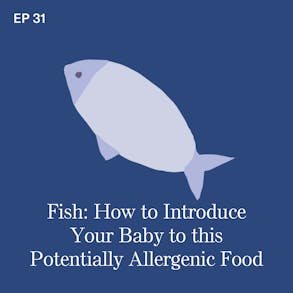
LISTEN TO THIS EPISODE
Episode Description
How can I safely feed my baby fish? Fish is one of the Big 8 allergenic foods (...the 8 foods that account for 90% of food allergy) and there’s no evidence that waiting to feed fish helps prevent allergy. So it is a food you can feed to your baby early and often, but with some precautions.
In this episode we talk about types of fish babies can safely eat, both canned and fresh and how to choose a fish to feed your baby. You’ll learn about environmental, nutrition and mercury considerations when selecting fish to feed your baby, plus some ideas on which fish foods to avoid for baby-led weaning and why.

Links from this Episode
- Food Allergy Research & Education at foodallergy.com is a great place to get information about particular food allergens, like fish & fish containing ingredients
- EPA & FDA Advice About Eating Fish (chart) for women who are or might become pregnant, breastfeeding mothers, and young children
- Seafoodwatch.org is the official site of the Monterey Bay Aquarium and helps people make better seafood choices for a healthy ocean.Their Seafood Recommendations page can help you make ocean-friendly choices wherever you are.
- Baby-Led Weaning with Katie Ferraro program with the 100 First Foods™ Daily Meal Plan, join here: https://babyledweaning.co/program
- Baby-Led Weaning for Beginners free online workshop with 100 First Foods™ list to all attendees, register here: https://babyledweaning.co/baby-led-weaning-for-beginners
Other episode related to this topic
- Episode 232 - Tuna Talk: Is it Safe for Babies to Eat Canned Tuna with @consumerreports Michael K. Hansen, PhD
Resources and Research
U.S. Food and Drug Administration. "ADVICE ABOUT EATING FISH For Those Who Might Become or Are Pregnant or Breastfeeding and Children Ages 1 – 11 Years." FDA, https://www.fda.gov/media/102331/download. Accessed April 17, 2025.

Latest Episodes

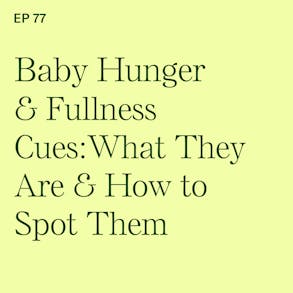
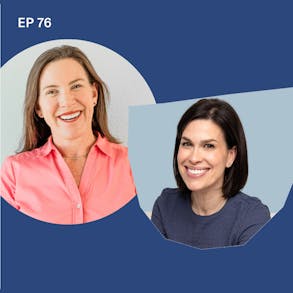
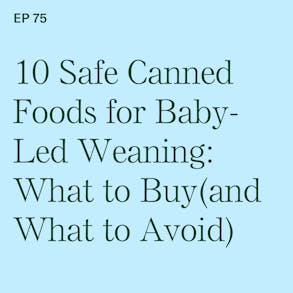

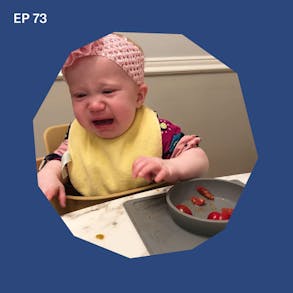
Ezpz (0s):
Real quick, I have a free gift offer for you. I love a free gift right now. EZPZ My favorite feeding gear company is giving away a free gift if until the end of April, you buy either their pre feeding set or their first food set. So the pre feeding set I love for three, four, and five month olds, it has a two pack of their tiny pops and their oral development tools. Those are the ones that help your baby learn to bite and munch and chew even before you start solid foods. Or if you've already started and you buy their first food set, that's the one that has one of the tiny bowls, one of the tiny cups, and a two pack of the tiny spoons. That's literally the only thing you need to start solid foods. When you buy either that pre feeding set or the first food set, you will get a free gift with your order. It's actually two free gifts, a little bundle that contains the EZPZ Baby-Led toothbrush and the easy peasy sensory tongue depressor. So if you've been learning about oral health and you're like, I gotta start the good oral health habits, EZPZ. Literally making it free for you to do with that Baby-Led toothbrush and the tongue depressor. When you purchase either the pre feeding set or the first food set, all you have to do is go to their website. So that's ezpzfun.com. And when you use the code baby lead at checkout, so that's babyled at checkout. If you buy either the first food set or the pre feeding set now until the end of April, that two pack for the free gift, the Baby-Led toothbrush and the sensory tongue depressor will ship with your order. That's a $12 offer. So it's a $12 free gift that you don't have to pay for. Again, the website is ezpzfun.com, use the code baby lead at checkout, and that is valid for us purchases only. Now through April 30th, when you're cooking a fatty fish for your baby, like let's say salmon, I generally won't add a ton of additional cooking oil. It's not necessary. You can add it if you want to, but for the white fish, the cooking preparation method is quite different. And because that's pure protein, which on one hand is good because it's the protein part of the food that we wanna introduce to your baby when we're introducing those allergenic foods, because it's pure protein, there's no fat. And so as a result, it can be a little bit on the dry side. So I'm gonna add a lot of additional cooking oil with those white fish so that when it cooks that oil, that fat is going to coat those protein strands and then when your baby goes to eat it, it makes it easier for them to safely swallow.
Katie Ferraro (2m 8s):
Hey there, I've Katie Ferraro, registered dietitian call nutrition professor and mom of seven specializing in Baby-Led Weaning. Here on the Baby-Led Weaning with Katie Ferraro podcast. I help you strip out all of the noise and nonsense about feeding, giving you the confidence and knowledge you need to give your baby a safe start to solid foods using Baby-Led Weaning Hello there and welcome back. Today we're talking about fish and how to safely introduce your baby to fish a potentially allergenic food. Now fish is one of the top nine allergenic foods. Those are the nine foods that account for about 90% of food allergy.
Katie Ferraro (2m 49s):
And then research shows us that there's no benefit to waiting or withholding fish foods for your baby. And in fact, as with the other potentially allergenic foods, early introduction of these potentially allergenic foods may actually have the ability to lower your baby's risk of food allergy down the road. So fish is separate from shellfish. Those are two different food categories at the top nine. We're gonna talk about shellfish in a separate episode. So today we're talking about finfish. So that can be fatty fish, that can be white fish. I got a lot of different ways that you can safely introduce your baby to fish. So each week I introduce two new podcast episodes. I do a mini solo training episode every Monday, and then I do a longer interview style episode on Thursday.
Katie Ferraro (3m 33s):
If you're not already subscribed to the show, please hit subscribe wherever you're listening or watching so that you can get notified when each of these episodes are live. But I like to start out these mini training episodes with a Baby-Led Weaning tip of the day. And today's tip is that even if you're a little freaked out about fish, and we're gonna talk about mercury too in today's episode, the benefits of offering your baby fish far outweigh any risks. So I do have a whole separate podcast episode all about mercury and mercury in fish, if that is something that scares you, especially with regards to tuna, a lot of parents are worried about tuna or they hear conflicting information. I did a wonderful interview with the head scientist from Consumer Reports.
Katie Ferraro (4m 17s):
So Consumer Reports has probably done the greatest amount of research and analysis on can tuna and mercury levels in this country. They've analyzed even the same samples that the US government, the EPA, and the Department of Health and Human Services who set the guidelines about mercury intake and you know, high mercury fish and low mercury fish. They have a different interpretation of that data and actually more stringent recommendations than the US government does. So if you're interested in learning more about tuna, I would really encourage you to go listen to episode 232. It's called Tuna Talk. Is it Safe for Babies to Eat canned tuna? That's with Consumer reports, Dr. Michael k Hansen. You can check that episode out at blwpodcast.com/232.
Katie Ferraro (4m 59s):
And again, the emphasis of that episode is all on canned tuna. Today we're gonna be talking about fresh fish and how you can offer your baby that fish protein without relying on tuna if that's something that you want to skip. So how common is fish allergy in the pediatric population? Research indicates that fish allergy affects about 0.2% of children around the world. So that is lower than milk, lower than egg, lower than peanut rates vary worldwide depending upon fish consumption, right? If it's not something that you're inclined to offer or include in your family meals that often, okay, we oftentimes we'll see lower rates of food allergy.
Katie Ferraro (5m 40s):
Is that because they're less allergic or is it just because we don't eat those foods? Now, the countries where fish intake is more common, particularly in Scandinavia, in Asia, fish allergy also tends to be more common. Fish allergy is one that can develop early or later in life, and it's one of those ones that you tend not to outgrow. So it often persists into adulthood. So what does the American Academy of Pediatrics say regarding fish? They recommend no need to delay fish. Okay, now that's remarkably different than what I learned as a dietitian. When I was in nutrition school 25 years ago, we learned about delaying introduction of egg and milk and peanut until after age one, two, and three.
Katie Ferraro (6m 21s):
There was all these different kind of like random guidelines about when you can introduce these protein foods, and none of it was actually based on any published research. Everything has changed with regards to early introduction of allergenic foods, all the data, all the guidelines. Now point to earlier introduction of these potentially allergenic foods. And so fish can safely be included in your baby's weaning diet when they're showing you those reliable signs of readiness to eat. So we want to introduce those potentially allergenic foods around six months in order to help lower your baby's risk of food allergy. Now, the guidelines in different parts of the world regarding fish are a little bit different than they're not exactly the same language.
Katie Ferraro (7m 3s):
I guess that the A A P uses, and I'll share some of them here briefly, but just notice that kind of everybody's pointing towards the early introduction, like when your baby's safe to start solid foods, then yes, you can do fish along with the other allergenic foods. I just don't recommend introducing two new allergenic foods at the same time for the first time. Right? If you did fish and shellfish, let's say you did like a fish cake that had crab, which is shellfish and pollock, which is a white fish mixed in it together, and your baby had had neither of those in the past, and if they had an allergic reaction, how would you know if they're reacting to the fish or to the shellfish? The European guidelines recommend introducing fish as early as they say, four to six months, alongside other complimentary foods. We of course know the benefits of exclusively breastfeeding until six months and not starting solid foods, until babies are showing the signs of readiness to eat.
Katie Ferraro (7m 49s):
That doesn't occur until the six month mark or beyond. So somewhere around the six month mark is when you'll want to start doing those fish foods. Now, is there any data that shows it's more protective if you introduce fish at four or five months compared to six months? No, that data does not exist. I always want to air on the side of safety. Offering foods before your baby is physiologically ready to eat them can increase the risk of choking. So we don't want to do those at four or five months. We want to hold off till six months if you can. In Australia, the guidelines are recommending the introduction of allergenic foods before 12 months, including fish. The United Kingdom, the NHS recommends fish introduction from around six months with safe preparation basically across the board.
Katie Ferraro (8m 31s):
Again, there's no evidence that delaying a fish introduction will reduce the risk of allergy. In fact, it's the opposite. Early introduction helps to lower your baby's risk of fish allergy. Hey, we're gonna take a quick break, but I'll be right back.
Momcozy (8m 48s):
I am working on my IBCLC breastfeeding credential right now. It is a long haul. I'm in the thick of it. I'm in a course that's very long, and the section that we're in right now is all about the different types of breast pumps. And let me tell you, breast pump technology has come a long way since the days of modifying dairy cow milking machines, and then trying to use them to extract human milk. There is a new breast pump on the market from Momcozy, which is a brand trusted by over 3 million moms worldwide. Momcozy just launched their air one ultra slim breast pump. I'm so excited to tell you about it. So here's the deal on the air one, this is a pump designed for busy moms on the go. It's ultra slim, it's discreet. Finally, a pump that will not slow you down. It's super compact and lightweight so you don't have to mess around with any more bulky, uncomfortable pumps. And the air one fits seamlessly inside your bra for total convenience. It has a transparent top for easy nipple alignment, because let's be real adjusting. A pump should not be a guessing game. It has a wireless charging case. You just pop it in, charge it up, and you're ready to go. No tangled cords, no stress. It's also whisper quiet operating at under 45 decibels so you can pump confidently anywhere without worrying about noise. Plus, the soft silicone flange makes it so comfortable to use air. One is available now at target.com or at your nearest target store. That's the Momcozy Air one Ultra Slim breast pump, available now at target.com or at your nearest target store, and you can learn more at momcozy.com.
Katie Ferraro (10m 27s):
Now, when do you not want to offer fish? If your baby has severe food allergy or other diagnosed food allergies, you're going to want to check with your primary care provider, as they might have an adjusted timeline for the introduction of allergenic foods, including fish. The other fish that we want to avoid are the high mercury fish. Okay? So these are the larger fish, the ones that are higher up on the food chain. So you think about it, mercury, which is a heavy metal that we unfortunately have in the food supply sometimes, and in certain fish it's if you're higher up on the food chain, you have eaten the other fish and bioaccumulate their mercury content as well. So we want to steer clear of the large high mercury fish like shark, swordfish, king mackerel, and tile fish.
Katie Ferraro (11m 11s):
So then how do you safely offer your baby fish? Well, you've always got to watch out for bones, okay? Fish needs to be prepared carefully for safety. If you are relying on canned fish, even if you see bones in there like canned salmon, just put your finger through that fish. As I always say with the meat and the protein foods, if you can shred the meat between your fingers and your thumb, then it's safe for your baby to eat with their gums. And even if you look at the bones in those canned fish products, you'll notice that they're incredibly soft and they just crumble right in your fingers. Okay? You put it in your own mouth, okay? And you'll realize, oh my gosh, this is totally soft and super safe for my baby to have. Now, you never know, sometimes an errant hard bone gets in there. So I always kind of do a once over and pick through any of the fish foods that I'm going to offer my baby.
Katie Ferraro (11m 54s):
I refrain from offering baby the skin of fish. I'll cook the fish with the skin on, okay? 'cause there's some great really, you know, those Omega-3 fatty acids, those essential fatty acids. You can find them in higher concentrations in fish foods, especially fatty fish. But from a choking standpoint, fish skin is a choking hazard. So I'm gonna once over and get the bones out, I'm gonna remove the skin before I offer it to the baby. So when the fish is cooked, I'll take those soft pieces that are cooked to the appropriate internal cooking temperature. And just as an aside, fish and shellfish should be cooked to a minimum internal temperature of 145 degrees Fahrenheit or 63 degrees centigrade in order to kill any potential pathogens. So I'll take that cooked fish and then cut it into pieces about the size of my adult pinky finger.
Katie Ferraro (12m 38s):
If I'm cooking those fatty fish, think of like salmon, right? That those that fat that's present, those are really, really good fats, and fat is your friend when your baby's starting solid foods because your baby needs the fat from some of those complimentary foods to help with their still developing brains. Maybe you've heard fish sometimes referred to as brain food. Okay? The Omega-3 fatty acids that we find in fish foods and fatty fish like salmon, that helps your baby still developing brain. So if I'm cooking with the fatty fish, I generally don't add a bunch of added oil. You can if you want to, but if I'm cooking white fish for babies, so thinking like tilapia or cot or halibut, I'm always gonna add some additional cooking oil in order to moisten things up.
Katie Ferraro (13m 18s):
Okay? Those white fish tend to be pure protein, which is great 'cause the fish protein is the potentially allergenic part of the food, but because there's no fat in them, they tend to be on the drier side. So I want to add oil when I'm cooking in order to add additional moisture, okay? That oil is gonna coat the protein strands of that fish, and it's going to make it easier for the baby to swallow. If you need ideas on how to prepare both fatty fish and white fish, if you have my original 100 First Foods list, if you scroll to the bottom of the list or look at the bottom of the list, you'll see the potentially allergenic foods. We have both white fish and fatty fish on the list because we have different preparation methods and recipes for the different ages and stages for both.
Katie Ferraro (13m 60s):
So if you're inside of my program, if you go to the that fish, and it's going to make it easier for the baby to swallow. If you need ideas on how to prepare both fatty fish and white fish, if you have my original 100 First Foods content library and you go to the potentially allergenic foods, go to F for fatty fish, W for whitefish, and you click in there, you can see all the recipes, the instructions, the videos on how to make those different types of fish safe for your baby's age end stage, if you want to check out that program and get all of this information, including the that fish, and it's going to make it easier for the baby to swallow. If you need ideas on how to prepare both fatty fish and white fish, if you have my original 100 First Foods Daily Meal Plan. So you never even have to think about which food to feed your baby next. It's all inside of my program called Baby-Led Weaning with Katie Ferraro. You can sign up for that program at babyledweaning.co/program. One of my favorite ways to do fish if you're not into doing those whole finger foods worth of fish is if your baby has already passed some of the allergenic foods.
Katie Ferraro (14m 44s):
So let's say you've already done egg and you've already done wheat. Make your baby a fish cake. It's kind of like a crab cake, okay? Just take whatever fish it is that you have. You can do it raw. I prefer to do it if I already have cooked fish leftover, I'll throw it in the food processor with an egg, some seasoning, half a cup of whatever cooked vegetable I might have laying around. Or you can skip that if you don't want to. Some Panko breadcrumbs. So those contain wheat, but they're low sodium Japanese style breadcrumbs. Pull some a few times in the food processor, throw some oil in a skillet, fry them into little fritters on each side till they're brown and the egg is set and cooked. Wait till that fritter is cool. Cut it into pieces about the size of your adult pinky finger, and it makes a beautiful finger food for your baby to pick up and feed to themself.
Katie Ferraro (15m 28s):
Have a number of different fish fritter recipes inside of the Baby-Led Weaning with Katie Ferraro program. If you want to learn more. Again, that website is babyledweaning.co/program. So I wanna wrap up by just a quick reminder that your baby can eat many more foods than we maybe give them credit for, but we do want to steer clear of those high mercury fish, king mackerel, marlin orange, ruffy shark, swordfish tilefish. That's from the Gulf of Mexico, and big eye tuna, some of my favorite fish for Baby-Led Weaning. Definitely love salmon, but I also love anchovies. I love sardines. We have those all on the that fish, and it's going to make it easier for the baby to swallow. If you need ideas on how to prepare both fatty fish and white fish, if you have my original 100 First Foods list, And I hope you will not be scared to try some fish foods out with your baby.
Katie Ferraro (16m 11s):
I will put the resources and links for everything I talked about in today's episode on the show notes page, which you can find at blwpodcast.com/31. A special thank you to our partners at AirWave Media. If you like podcasts that feature food and science and using your brain, check out some of the podcasts from AirWave. We're online at blwpodcast.com. Thanks so much for listening, And I'll see you next time.
America's Test Kitchen (16m 44s):
Hey everyone, it's Dan Souza from America's Test Kitchen. I'm super excited to let you all know that we're launching a new video podcast that takes you behind the scenes into the messy, imperfect, but riveting day-to-day life right here in our test kitchen. Not only do I get to talk to my colleagues about the latest taste test they attended, I Just came from a tasting of salted caramel wapa pie bars, and then roasted garlic, so I apologize, Or about a recipe they're developing. The Thing about this recipe is it's a secret. The restaurateur refuses to tell people what her secret ingredients are. We also chat with amazing guests from the culinary world and beyond the lamest joke I've ever said, no, it's, And I said to Marie, ma, that's a great, it's the, it's, you definitely said the worst jokes. Thanks. Thanks, Sam. Make sure to subscribe to In the Test Kitchen so you don't miss an episode. You can watch in the test kitchen on YouTube and Spotify and listen to it wherever you get your podcasts. Can't wait to see you in the test kitchen.
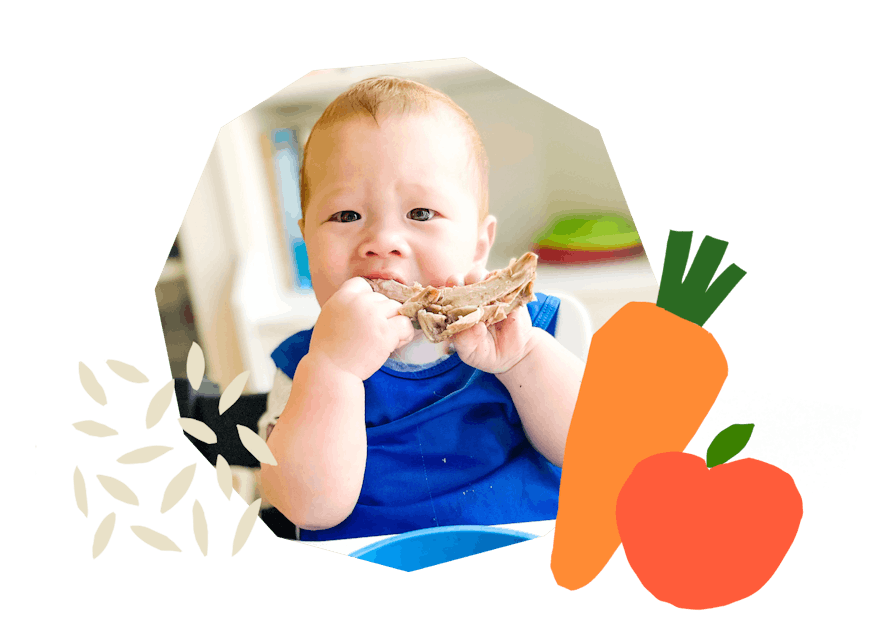
The Program Baby-Led Weaning with Katie Ferraro
A step-by-step digital program for starting solid foods safely and navigating the original 100 FIRST FOODS™ meal plan with baby-led weaning.
 EXPERT-LED, PROVEN APPROACH TO EATING REAL FOOD
EXPERT-LED, PROVEN APPROACH TO EATING REAL FOOD CONCISE VIDEO TRAININGS TO MASTER BABY-LED WEANING
CONCISE VIDEO TRAININGS TO MASTER BABY-LED WEANING 100 FIRST FOODS DAILY MEAL PLAN WITH FOOD PREP VIDEOS
100 FIRST FOODS DAILY MEAL PLAN WITH FOOD PREP VIDEOS
Baby-Led Weaning for Beginners Free Workshop
Is your baby ready to start solid foods, but you’re not sure where to start? Get ready to give your baby a solid foundation to a lifetime of loving real food…even if you’re feeling overwhelmed or confused about this next stage of infant feeding.
Get baby-led weaning recipes and tips delivered to your email inbox.

